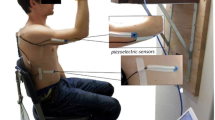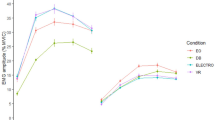Summary
In order to verify whether the method employed to obtain an isometric contraction has any effects on the time for which the contraction can be sustained as well as the consequent cardiocirculatory responses, nine male subjects, from 23 to 42 years of age, carried out isometric contractions of the elbow flexor muscles against either a suspended weight (W) or a fixed strain gauge (SG). The maximum voluntary contraction (MVC) appears to be identical in both instances; and, for a given percentage of MVC, the limit-time of the isometric contraction and its accompanying heart rate changes reveal no significant differences in the two cases.
Similar content being viewed by others
References
Caldwell LS (1964) Measurement of static muscle endurance. J Engin Psychol 3:16–22
Carlson BR (1969) Level of maximum isometric strength and relative load isometric endurance. Ergonomics 12:429–435
Clarke RSJ, Hellon RF, Lind AR (1958) The duration of sustained contractions of the human forearm at different muscle temperatures. J Physiol [Lond] 143:454–473
Goodwin GM, Mc Closkey DI, Mitchell JH (1972) Cardiovascular and respiratory responses to changes in central command during isometric exercise at constant muscle tension. J Physiol [Lond] 226:173–190
Hansen OE, Maggio M (1960) Static work and heart rate. Int Z Angew Physiol Arbeitsphysiol 18:242–247
Kahn JF, Stouvenel O, Monod H (1984) Réactions cardiocirculatoires à un travail statique réalisé dans deux positions chez l'homme et chez la femme. Travail Humain 47:307–316
Lind AR, Petrofsky JS (1979) The amplitude of the surface EMG during fatiguing isometric contractions. Muscle Nerve 2:157–264
Mc Closkey DI, Matthews PBC, Mitchell JH (1972) Absence of appreciable cardiovascular and respiratory responses to muscle vibration. J Appl Physiol 33:623–626
Mitchell JH, Schibye B, Payne FC, Saltin B (1981) Response of arterial blood pressure to static exercise in relation to muscle mass, force development, and electromyographic activity. Circ Res 48: [Suppl I] 70–75
Monod H (1956) Contribution à l'étude du travail statique. Thèse Méd, Paris
Monod H, Scherrer J (1957) Capacité de travail statique d'un groupe musculaire synergique chez l'homme. CR Soc Biol 151:1358–1369
Monod H (1979) Un dispositif pour la mesure des forces musculaires chez l'homme. Travail Humain 43:213–214
Morehouse CA (1967) Development and maintenance of isometric strength of subjects with diverse initial strengths. Res Quart 38:449–456
Reinberg A (1979) Circadian and circannual rhythms in healthy adults. Nato-Agard, sleep,wakefulness and circadian rhythm, Paris. In Agard-L.S. 105:1/15–1/27
Rohmert W (1960) Ermittlung von Erholungspausen für statische Arbeit des Menschen. Int Z Angew Physiol Arbeitsphysiol 18:123–164
Author information
Authors and Affiliations
Rights and permissions
About this article
Cite this article
Kahn, J.F., Kapitaniak, B. & Monod, H. Comparison of two modalities when exerting isometric contractions. Europ. J. Appl. Physiol. 54, 331–335 (1985). https://doi.org/10.1007/BF00426155
Accepted:
Issue Date:
DOI: https://doi.org/10.1007/BF00426155




